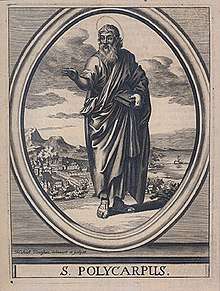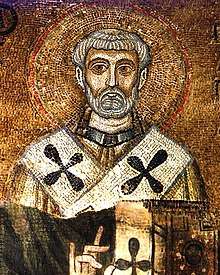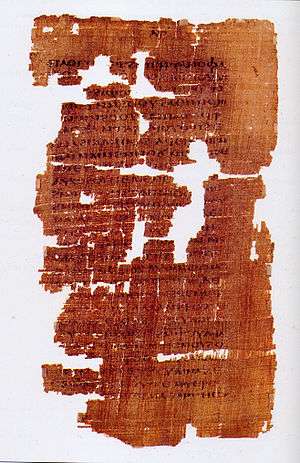Apostolic Fathers
The Apostolic Fathers were core Christian theologians among the Church Fathers who lived in the 1st and 2nd centuries AD, who are believed to have personally known some of the Twelve Apostles, or to have been significantly influenced by them.[1] Their writings, though widely circulated in Early Christianity, were not included in the canon of the New Testament. Many of the writings derive from the same time period and geographical location as other works of early Christian literature which came to be part of the New Testament. Some of the writings found among the Apostolic Fathers appear to have been as highly regarded as some of the writings which became the New Testament.
Background
The label Apostolic Fathers has been applied to these writers only since the 17th century, to indicate that they were thought of as representing the generation that had personal contact with the Twelve Apostles.[1] The earliest known use of the term "Apostolic(al) Fathers" was by William Wake in 1693, when he was chaplain in ordinary to King William and Queen Mary of England.[2] According to the Catholic Encyclopedia, the use of the term Apostolic Fathers can be traced to the title of a 1672 work by Jean-Baptiste Cotelier, SS. Patrum qui temporibus apostolicis floruerunt opera ("Works of the holy fathers who flourished in the apostolic times"), which was abbreviated to Bibliotheca Patrum Apostolicorum (Library of the Apostolic Fathers) by L. J. Ittig in his 1699 edition of the same.[1]
The history of the title for these writers was explained by Joseph Lightfoot, in his 1890 translation of the Apostolic Fathers' works:[3]
...[T]he expression ['Apostolic Fathers'] itself does not occur, so far as I have observed, until comparatively recent times. Its origin, or at least its general currency, should probably be traced to the idea of gathering together the literary remains of those who flourished in the age immediately succeeding the Apostles, and who presumably therefore were their direct personal disciples. This idea first took shape in the edition of Cotelier during the last half of the seventeenth century (A.D. 1672). Indeed such a collection would have been an impossibility a few years earlier. The first half of that century saw in print for the first time the Epistles of Clement (A.D. 1633), and of Barnabas (A.D. 1645), to say nothing of the original Greek of Polycarp's Epistle (A.D. 1633) and the Ignatian Letters in their genuine form (A.D. 1644, 1646). The materials therefore would have been too scanty for such a project at any previous epoch. In his title page however Cotelier does not use the actual expression, though he approximates to it, SS. Patrum qui temporibus Apostolicis floruerunt opera; but the next editor [Thomas] Ittig (1699), adopts as his title Patres Apostolici, and thenceforward it becomes common.
List of works
The following writings are generally grouped together as having been written by the Apostolic Fathers:[4]
- The Epistle to Diognetus[note 1]
- Letters attributed to Clement of Rome
- The First Epistle of Clement
- The Second Epistle of Clement (not actually written by Clement; see § Clement of Rome)
- The Didache
- The Epistle of Barnabas
- Seven epistles attributed to Ignatius of Antioch (the longer forms of these Epistles, and those beyond the seven, are widely considered later emendations and forgeries)
- The Epistle of Polycarp
- The Martyrdom of Polycarp
- The Shepherd of Hermas
- Fragments of the writings of Papias of Hierapolis, which have survived as quotations in later writers
- One short fragment of a writing by Quadratus of Athens (this does not appear in most editions before c. 1980)
All or most of these works were originally written in Greek. Older English translations of these works can be found online in the Ante-Nicene Fathers series on the Christian Classics Ethereal Library website.[5] Published English translations have also been made by various scholars of early Christianity, such as Joseph Lightfoot, Kirsopp Lake, Bart D. Ehrman and Michael W. Holmes.[note 2] The first English translation of the Apostolic Fathers' works was published in 1693, by William Wake (1657–1737), then rector of Westminster St James, later (1716) Archbishop of Canterbury.[note 3] It was virtually the only English translation available until the mid-19th century. Since its publication many better manuscripts of the Apostolic Fathers' works have been discovered.[note 4]
There are several Greek text editions:
- The Apostolic Fathers. Vol. 1. I Clement. II Clement. Ignatius. Polycarp. Didache. Barnabas. Loeb Classical Library. Cambridge: Harvard University Press, 1912 Kirsopp Lake
- The Apostolic Fathers. Vol. 2. Shepherd of Hermas. Martyrdom of Polycarp. Epistle to Diognetus. Loeb Classical Library. Cambridge: Harvard University Press, 1913 Kirsopp Lake
- The Apostolic Fathers. Vol. 1. I Clement. II Clement. Ignatius. Polycarp. Didache. Loeb Classical Library. Cambridge: Harvard University Press, 2003 Bart Ehrman (replaced Lake)
- The Apostolic Fathers. Vol. 2. Epistle of Barnabas. Papias and Quadratus. Epistle to Diognetus. The Shepherd of Hermas. Loeb Classical Library. Cambridge: Harvard University Press, 2005 Bart Ehrman (replaced Lake)
- The Apostolic Fathers: Greek Texts and English Translations. 3rd Edition. Grand Rapids: Baker, 2007 Michael Holmes
- Die Apostolischen Väter. Tübingen: Mohr Siebeck, 1992 Andreas Lindemann and Henning Paulsen (German)
Fathers
Clement of Rome
The First Epistle of Clement (c. AD 96)[6] was copied and widely read and is generally considered to be the oldest Christian epistle in existence outside of the New Testament. The letter is extremely lengthy, twice as long as the Epistle to the Hebrews,[note 5] and it demonstrates the author's familiarity with many books of both the Old Testament and New Testament. The epistle repeatedly refers to the Old Testament as scripture[7] and includes numerous references to the Book of Judith, thereby establishing usage or at least familiarity with Judith in his time. Within the letter, Clement calls on the Christians of Corinth to maintain harmony and order.[6] Tradition identifies the author as Clement, bishop of Rome, and scholarly consensus is overwhelmingly in favor of the letter's authenticity.[8] Early church lists place him as the second or third[9][10][11][note 6] bishop of Rome, although "there is no evidence for monarchical episcopacy in Rome at so early a date".[9]
The Second Epistle of Clement was traditionally ascribed to Clement, but it is now generally considered to have been written later, c. AD 140–160, and therefore could not be the work of Clement, who died in AD 99.[12] Whereas 1 Clement was an epistle, 2 Clement appears to be a transcript of an oral homily or sermon,[12] making it the oldest surviving Christian sermon outside of the New Testament.
Ignatius of Antioch
Ignatius of Antioch (also known as Theophorus, from the Greek for God-bearer) (c. 35–110)[13] was bishop of Antioch.[14] He may have known the apostle John directly, and his thought is certainly influenced by the tradition associated with this apostle.[15] En route to his martyrdom in Rome, Ignatius wrote a series of letters which have been preserved as an example of the theology of the earliest Christians. Important topics addressed in these letters include ecclesiology, the sacraments, the role of bishops,[16] and the nature of biblical Sabbath.[17] He clearly identifies the local-church hierarchy composed of bishop, presbyters, and deacons and claims to have spoken in some of the churches through the inspiration of the Holy Spirit. He is the second after Clement to mention the Pauline epistles.[6]
Polycarp of Smyrna

Polycarp of Smyrna (c. AD 69 – c. 155) was bishop of Smyrna (now İzmir in Turkey). His student Irenaeus wrote that he "was not only instructed by the apostles, and conversed with many who had seen the Lord, but was also appointed bishop by apostles in Asia and in the church in Smyrna",[18] and that he himself had, as a boy, listened to "the accounts which (Polycarp) gave of his intercourse with John and with the others who had seen the Lord".[19] The options for this John are John the son of Zebedee, traditionally viewed as the author of the Fourth Gospel, or John the Presbyter.[20] Traditional advocates follow Eusebius in insisting that the apostolic connection of Papius was with John the Evangelist, and that this John, the author of the Gospel of John, was the same as the apostle John. Polycarp tried and failed to persuade Anicetus, bishop of Rome, to have the West celebrate Easter on 14 Nisan, as in the East. He rejected the Bishop's suggestion that the East use the Western date. In 155, the Smyrnans demanded Polycarp's execution as a Christian, and he died a martyr. His story has it that the flames built to kill him refused to burn him, and that when he was stabbed to death, so much blood issued from his body that it quenched the flames around him.[6] Polycarp is recognized as a saint in both the Roman Catholic and Eastern Orthodox churches.
Didache
The Didache (Greek: Διδαχή,, translit. Didakhé, lit. "Teaching")[21] is a brief early Christian treatise, dated anywhere from as early as AD 50 to the end of the 1st Century.[22] It contains instructions for Christian communities. The text, parts of which may have constituted the first written catechism, has three main sections dealing with Christian lessons, rituals such as baptism and the Eucharist, and church organization. It was considered by some of the Church Fathers as part of the New Testament,[23] but rejected as spurious (non-canonical) by others.[24] Scholars knew of the Didache through references in other texts, but the text itself had been lost; it was rediscovered in 1873.
Shepherd of Hermas
The 2nd-century Shepherd of Hermas was popular in the early church, and was even considered scriptural by some of the Church Fathers, such as Irenaeus and Tertullian. It was written in Rome in Koine Greek. The Shepherd had great authority in the 2nd and 3rd centuries. The work comprises five visions, 12 mandates, and 10 parables. It relies on allegory and pays special attention to the Church, calling the faithful to repent of the sins that have harmed it.
See also
- Church Fathers
- Doctor of the Church
- Ante-Nicene Fathers (book)
- Ecumenical Councils
- Nicene and Post-Nicene Fathers
- Twelve Apostles
- Seventy Apostles
- Saints
References
Notes
- Some editors place the Epistle to Diognetus among the apologetic writings, rather than among the Apostolic Fathers (Stevenson, J. A New Eusebius SPCK (1965) p. 400).
- For a review of the most recent editions of the works of the Apostolic Fathers and an overview of the current state of scholarship, see Sailors, Timothy B. "Bryn Mawr Classical Review: Review of The Apostolic Fathers: Greek Texts and English Translations". Archived from the original on 7 June 2011. Retrieved 13 January 2017.
- The translation was entitled The Genuine Epistles of the Apostolical Fathers, St. Barnabas, St. Clement, St. Ignatius, St. Polycarp, the Shepherd of Hermas, and the Martyrdoms of St. Ignatius and St. Polycarp written by Those who were Present at Their Sufferings.
- Wake's 1693 translation is still available to this day, reprinted in a volume (first published in 1820) now being sold under the title The Lost Books of the Bible and the Forgotten Books of Eden, which is described at length in chapter 15 of Edgar J. Goodspeed, Modern Apocrypha (Boston: Beacon Press, 1956).
- The Lightfoot translation of the First Epistle of Clement is 13,316 words; the Epistle to the Hebrews is only 7,300-400 words (depending on the translation).
- The Catholic Encyclopedia says that no critic now doubts that the names Cletus and Anacletus in lists that would make Clement the fourth successor of Saint Peter refer to the one person, not two.
Citations
-

- See H.J. de Jonge: On the origin of the term "Apostolic Fathers"; but note now D. Lincicum, "The Paratextual Invention of the Term 'Apostolic Fathers'," Journal of Theological Studies (2015)
- J.B. Lightfoot, The Apostolic Fathers, (1890, second ed., London, Macmillan & Co.) volume 1, page 3. See also, David Lincincum, The Paratextual Invention of the Term 'Apostolic Fathers', The Journal of Theological Studies, n.s. vol. 66, nr. 1 (April 2015) pages 139-148; H.J. de Jonge, On the Origin of the Term 'Apostolic Fathers', The Journal of Theological Studies, n.s. vol. 29, nr. 2 (Oct. 1978) pages 503-505.
- "Apostolic Fathers, The". In Cross, F. L., and Livingstone, E.A., eds. The Oxford Dictionary of the Christian Church. Oxford University Press (1974).
- "The Apostolic Fathers with Justin Martyr and Irenaeus". Christian Classics Ethereal Library. Harry Plantinga. Retrieved 30 June 2016.
- Durant, Will (1972). Caesar and Christ. New York: Simon & Schuster.
- B. Metzger, Canon of the New Testament (Oxford University Press) 1987:43.
- Louth 1987:20; preface to both epistles in William Jurgens The Faith of the Early Fathers, vol 1", pp 6 and 42 respectively.
- "Clement of Rome, St." Cross, F. L., ed. The Oxford dictionary of the Christian church. New York: Oxford University Press. 2005
- History of the Christian Church, Volume II: Ante-Nicene Christianity, AD 100-325 - "Clement of Rome"
- Annuario Pontificio (Libreria Editrice Vaticana 2008 ISBN 978-88-209-8021-4), p. 7*
-

- See "Ignatius" in The Westminster Dictionary of Church History, ed. Jerald Brauer (Philadelphia:Westminster, 1971) and also David Hugh Farmer, "Ignatius of Antioch" in The Oxford Dictionary of the Saints (New York:Oxford University Press, 1987).
- "Ignatius, St." Cross, F. L., ed. The Oxford dictionary of the Christian church. New York: Oxford University Press. 2005
- "Saint Ignatius of Antioch" in the Encyclopædia Britannica.
- Eph 6:1, Mag 2:1,6:1,7:1,13:2, Tr 3:1, Smy 8:1,9:1
- Ignatius's Letter to the Magnesians 9: "Let us therefore no longer keep the Sabbath after the Jewish manner"
- Adversus haereses, 3:3:4
- Letter to Florinus, quoted in Eusebius, Ecclesiastical History, Book V, chapter 20.
- Lake (1912).
- Liddell, Henry George; Scott, Robert (1940). "διδαχή". A Greek–English Lexicon. Revised and augmented throughout by Sir Henry Stuart Jones, with the assistance of Roderick McKenzie. Oxford: Clarendon Press.
- Cross, edited by F.L. (2005). The Oxford dictionary of the Christian Church (3rd rev. ed.). Oxford: Oxford University Press. p. 482. ISBN 978-0192802903. Retrieved 8 March 2016
- Apostolic Constitutions "Canon 85" (approved at the Orthodox Synod of Trullo in 692); Rufinus, Commentary on Apostles Creed 37 (as Deuterocanonical) c. 380; John of Damascus Exact Exposition of Orthodox Faith 4.17; and the 81-book canon of the Ethiopian Orthodox Church which includes the Didascalia which is based on the Didache.
- Athanasius, Festal Letter 39 (excludes them from the canon, but recommends them for reading) in 367; Rejected by 60 Books Canon and by Nicephorus in Stichometria
External links
- Catholic Encyclopedia: Apostolic Fathers
- Bartlet, James Vernon (1911). . In Chisholm, Hugh (ed.). Encyclopædia Britannica. 2 (11th ed.). Cambridge University Press. pp. 201–204. This contains a more detailed exegesis of the writings.
- Apostolic Fathers in the Christian Cyclopedia
- SBL Apostolic Fathers Section
.jpg)

